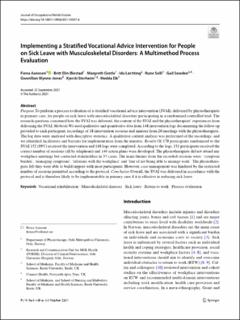| dc.contributor.author | Øiestad, Britt Elin | |
| dc.contributor.author | Grotle, Margreth | |
| dc.contributor.author | Løchting, Ida | |
| dc.contributor.author | Solli, Rune | |
| dc.contributor.author | Sowden, Gail | |
| dc.contributor.author | Wynne-Jones, Gwenllian | |
| dc.contributor.author | Storheim, Kjersti | |
| dc.contributor.author | Eik, Hedda | |
| dc.date.accessioned | 2021-11-01T10:37:16Z | |
| dc.date.available | 2021-11-01T10:37:16Z | |
| dc.date.created | 2021-10-05T12:10:59Z | |
| dc.date.issued | 2021-10-04 | |
| dc.identifier.issn | 1053-0487 | |
| dc.identifier.issn | 1573-3688 | |
| dc.identifier.uri | https://hdl.handle.net/11250/2826802 | |
| dc.description.abstract | Purpose: To perform a process evaluation of a stratified vocational advice intervention (SVAI), delivered by physiotherapists in primary care, for people on sick leave with musculoskeletal disorders participating in a randomised controlled trial. The research questions concerned how the SVAI was delivered, the content of the SVAI and the physiotherapists’ experiences from delivering the SVAI. Methods: We used qualitative and quantitative data from 148 intervention logs documenting the follow-up provided to each participant, recordings of 18 intervention sessions and minutes from 20 meetings with the physiotherapists. The log data were analysed with descriptive statistics. A qualitative content analysis was performed of the recordings, and we identified facilitators and barriers for implementation from the minutes. Results: Of 170 participants randomised to the SVAI 152 (89%) received the intervention and 148 logs were completed. According to the logs, 131 participants received the correct number of sessions (all by telephone) and 146 action plans were developed. The physiotherapists did not attend any workplace meetings but contacted stakeholders in 37 cases. The main themes from the recorded sessions were: ‘symptom burden’, ‘managing symptoms’, ‘relations with the workplace’ and ‘fear of not being able to manage work’. The physiotherapists felt they were able to build rapport with most participants. However, case management was hindered by the restricted number of sessions permitted according to the protocol. Conclusion: Overall, the SVAI was delivered in accordance with the protocol and is therefore likely to be implementable in primary care if it is effective in reducing sick leave. | en_US |
| dc.description.sponsorship | Open access funding provided by OsloMet - Oslo Metropolitan University. This study was funded by The Research Council of Norway, The Norwegian Labour and Welfare Administration (NAV), Oslo Metropolitan University and The Norwegian Fund for Post-Graduate Training in Physiotherapy. | en_US |
| dc.language.iso | eng | en_US |
| dc.publisher | Springer | en_US |
| dc.relation.ispartofseries | Journal of occupational rehabilitation; | |
| dc.rights | Navngivelse 4.0 Internasjonal | * |
| dc.rights.uri | http://creativecommons.org/licenses/by/4.0/deed.no | * |
| dc.subject | Vocational rehabilitations | en_US |
| dc.subject | Musculoskeletal diseases | en_US |
| dc.subject | Sick leaves | en_US |
| dc.subject | Work returns | en_US |
| dc.subject | Process evaluations | en_US |
| dc.title | Implementing a Stratified Vocational Advice Intervention for People on Sick Leave with Musculoskeletal Disorders: A Multimethod Process Evaluation | en_US |
| dc.type | Peer reviewed | en_US |
| dc.type | Journal article | en_US |
| dc.description.version | publishedVersion | en_US |
| dc.rights.holder | © The Author(s) 2021 | en_US |
| cristin.ispublished | true | |
| cristin.fulltext | original | |
| cristin.qualitycode | 1 | |
| dc.identifier.doi | https://doi.org/10.1007/s10926-021-10007-6 | |
| dc.identifier.cristin | 1943375 | |
| dc.source.journal | Journal of occupational rehabilitation | en_US |
| dc.source.pagenumber | 1-13 | en_US |
| dc.relation.project | Norges forskningsråd: 280431 | en_US |

